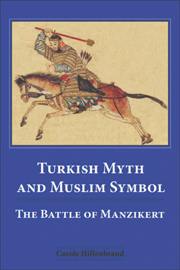Book contents
- Frontmatter
- Contents
- List of figures
- List of plates
- Acknowledgements
- Comment on transliteration and conventions used in the book
- Dedication
- Part 1 Medieval Muslim interpretations of the battle of Manzikert
- Part 2 The legacy of the battle
- 6 The ongoing Muslim–Christian confrontation: the victorious contribution of the Turks
- 7 The heritage of Manzikert: the myth of national identity
- Conclusion
- Appendix A The account of the battle of Manzikert by Michael Attaleiates, translated by Ruth Macrides
- Appendix B Translations of some other medieval Christian accounts of the battle of Manzikert
- Appendix C Other medieval Muslim accounts of the battle of Manzikert
- Bibliography
- Index
- Plate section
6 - The ongoing Muslim–Christian confrontation: the victorious contribution of the Turks
from Part 2 - The legacy of the battle
Published online by Cambridge University Press: 05 August 2013
- Frontmatter
- Contents
- List of figures
- List of plates
- Acknowledgements
- Comment on transliteration and conventions used in the book
- Dedication
- Part 1 Medieval Muslim interpretations of the battle of Manzikert
- Part 2 The legacy of the battle
- 6 The ongoing Muslim–Christian confrontation: the victorious contribution of the Turks
- 7 The heritage of Manzikert: the myth of national identity
- Conclusion
- Appendix A The account of the battle of Manzikert by Michael Attaleiates, translated by Ruth Macrides
- Appendix B Translations of some other medieval Christian accounts of the battle of Manzikert
- Appendix C Other medieval Muslim accounts of the battle of Manzikert
- Bibliography
- Index
- Plate section
Summary
God made the sun rise from the zodiac of the Turks; made the states, which resemble the spheres in the heavens, revolve within the circle of their authority; and made the Turks the masters over the face of the earth
(Mahmud Kashgari)Introductory comments
Almost from the very moment that the sedentary Muslims of Iran and Iraq realised that the new Islamic military elite – the leaders of the nomadic Turks – were going to remain inside the Islamic world, the scholarly and bureaucratic Arab and Persian establishment began to write works justifying the Turkish seizure of power. Their panegyrics, in prose and poetry, praised the military prowess of the Turks, their prosecution of jihād and the respectability of their credentials as Sunni Muslims. The bureaucrat Ibn Hassul, working in the service of the Seljuqs in the 1050s, extols the virtues of the first Seljuq sultan, Tughril (ruled 431–55/1040–63), emphasising his justice and mercy. Speaking of the Turks in general, he singles out their heroism and endurance:
God has created them in the shape of lions, with broad faces and flat noses. Their muscles are strong, their fists are enormous and their bodies hairless … They are accustomed to desert and steppe … When they gallop their horses they continue as vigorously as when they began … They ascend high mountains, ride in the face of danger, climb distant peaks, raid narrow abysses, and go deep into unknown lands.
- Type
- Chapter
- Information
- Turkish Myth and Muslim SymbolThe Battle of Manzikert, pp. 147 - 195Publisher: Edinburgh University PressPrint publication year: 2007



